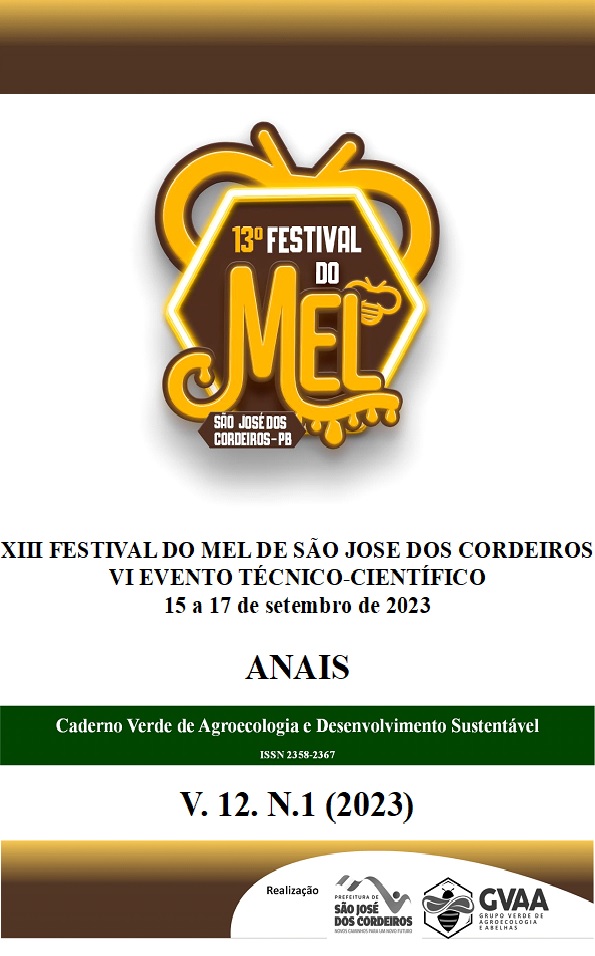Analysis of richness and evenness in the abundance of bacteria that make up the intestinal microbiota of Apis mellifera bees from different biomes in Paraíba
Keywords:
Microbiota intestinal, Riqueza, UniformidadeAbstract
The Africanized honey bee (Apis mellifera scutellata x spp.) is a polyhybrid originated from the crossbred between the African subspecies Apis mellifera scutellata and European subspecies and was developed in Brazil in the mid-twentieth century. As in many other beings, the intestine of bees is dominated by a range of microorganisms that perform several important functions for the metabolism, digestion and immunity of their hosts. It is known that the landscape where bees are inserted models the composition and diversity of the intestinal microbiota. A diverse community of bacteria guarantees the diversity of functions as well as the uniformity in the distribution of the abundance of these microorganisms, which is a sign that none or few of them stand out, as this is a sign of dysbiosis. In order to compare the phylogenetic diversity of the intestinal microbiota of A. mellifera bees, 5 samples of 20 individuals were collected from different hives belonging to the Federal University of Paraíba from different regions of the State, Areia (Atlantic Forest) and São João do Cariri (Caatinga), and sent to the Laboratory of Analysis of Products of Animal Origin (LAPOA / CCA / UFPB), in the municipality of Areia - PB. In a sterile environment, all the abdominal contents of the bees were collected and the DNA was extracted. Genomic libraries were prepared and sequencing was performed on a MiSeq equipment (Illumina). The obtained sequences were processed using the DADA2 software. The Shannon richness and Pielou evenness indexes were obtained using the QIIME 2-2020 platform, and the indexes for each region were compared using the Kruskal-Wallis test at 5% probability. The Shannon and Pielou diversity indexes did not differ significantly (Shannon index p-value = 0.754; Pielou index p-value = 0.754) among samples from different biomes in Paraíba. Bees from different biomes showed similar richness, abundance and distribution of abundances.
Downloads
Published
How to Cite
Issue
Section
License
Copyright (c) 2023 Kilmer Oliveira Soares, Thamara Ferreira da Rocha, Adryele Gomes Maia, Adriana Evangelista Rodrigues, Celso José Bruno de Oliveira, Rosilene Agra da Silva; Aline Carla de Medeiros; Patricio Borges

This work is licensed under a Creative Commons Attribution 4.0 International License.
Termo de cessão de direitos autorias
Esta é uma revista de acesso livre, em que, utiliza o termo de cessão seguindo a lei nº 9.610/1998, que altera, atualiza e consolida a legislação sobre direitos autorais no Brasil.
O(s) autor(es) doravante designado(s) CEDENTE, por meio desta, publica a OBRA no Caderno Verde de Agroecologia e Desenvolvimento Sustentável, representada pelo Grupo Verde de Agroecologia e Abelhas (GVAA), estabelecida na Rua Vicente Alves da Silva, 101, Bairro Petrópolis, Cidade de Pombal, Paraíba, Brasil. Caixa Postal 54 CEP 58840-000 doravante designada CESSIONÁRIA, nas condições descritas a seguir:
O CEDENTE declara que é (são) autor(es) e titular(es) da propriedade dos direitos autorais da OBRA submetida.
O CEDENTE declara que a OBRA não infringe direitos autorais e/ou outros direitos de propriedade de terceiros, que a divulgação de imagens (caso as mesmas existam) foi autorizada e que assume integral responsabilidade moral e/ou patrimonial, pelo seu conteúdo, perante terceiros.
O CEDENTE mantêm os direitos autorais e concedem à revista o direito de divulgação da OBRA, com o trabalho simultaneamente licenciado sob a Licença Creative Commons do tipo atribuição CC-BY.
O CEDENTE têm autorização para distribuição não-exclusiva da versão do trabalho publicada nesta revista.
O CEDENTE têm permissão e são estimulados a publicar e distribuir seu trabalho online (ex.: em repositórios institucionais ou na sua página pessoal) a qualquer ponto antes ou durante o processo editorial, já que isso pode gerar alterações produtivas, bem como aumentar o impacto e a citação do trabalho publicado.








